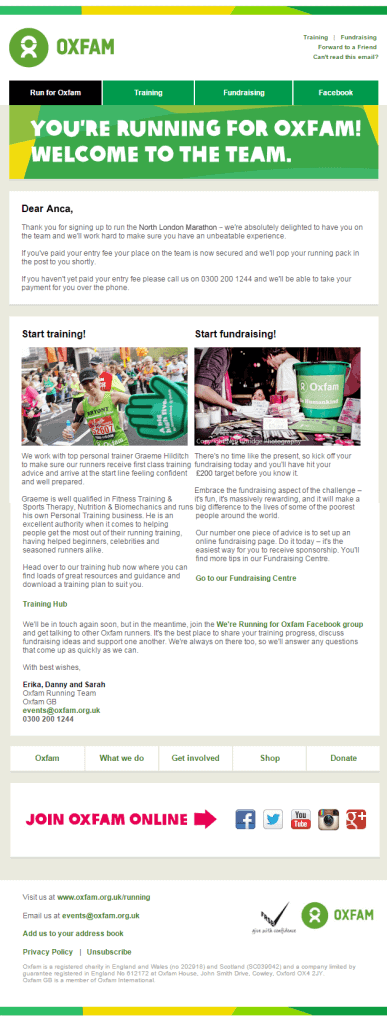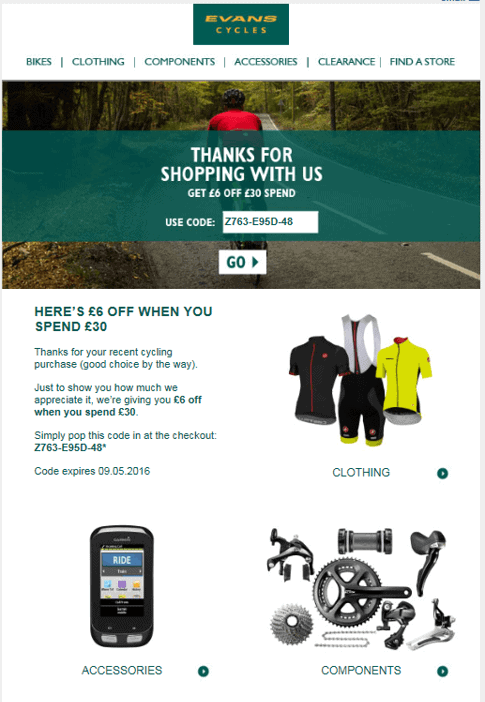When exactly does a customer conversion occur?
Is it when someone opts in to email? When someone subscribes to your service? The first time he or she makes a purchase?
You may have a different answer depending on your business model. But we’d like to suggest a different way of looking at conversions: It’s an ongoing process that, ideally, leads prospects and customers down a path toward deeper engagement.
Welcome aboard
The first step down this path is what people traditionally think of as onboarding: a welcome email when someone has opted in. But a good welcome email doesn’t simply confirm registration; it nudges the recipient down that engagement path.
Oxfam, the charitable organization focused on alleviating global poverty, used an onboarding email to get people who signed up for a charity run to take the next step: paying the entry fee. Oxfam sent an automated welcome message within 24 hours of registration.
Coupled with a clear subject line, the email achieved a 79 percent open rate.

Oxfam’s welcome email illustrates a few best practices:
- It’s from a real person: This helps to make the recipient feel connected to the organization.
- The tone is warm: From the header and personalized salutation to the “best wishes” above the signature, the email is friendly and encouraging.
- It contains a clear call to action: The desired outcome of paying the registration fee is the first block of text. The action is positioned as a benefit to the recipient: Your place on the team is secure and you’ll soon get a free pack.
- It encourages further engagement: The email offers two choices for getting started, with links to further resources.
Online retailers can encourage engagement by offering shop-now discounts, coupons or product recommendations. App developers and software service providers can guide new users to set up the service or take an action that shows the value of the product.
Onboarding flow
While using these best practices for welcome emails can increase opens and engagement, it’s a fact of the marketer’s life that not all emails are opened.
Using a trigger-based marketing automation program, you can set up decision trees that automate future onboarding emails based on consumer behaviors.
For example, someone who opens the welcome email and takes an action is well on the way to true conversion. You can begin to send him or her more personalized messages that offer deeper engagement.
Those who don’t open the welcome email should receive a time-based reminder. How long to wait before sending that reminder varies. Some companies send a follow-up the next day when consumer interest is presumably high. Others may wait a week or longer.
British pet-rescue organization Blue Cross waits 20 days before sending the follow-up email that discusses what the organization does and how it helps. Because it uses conversion tracking on all emails sent, it has segmented its audience to create separate donor journeys.
(For a deeper discussion of how triggers can be used throughout the customer journey, read this post.)
Encouraging engagement
Even if a customer has converted by purchasing a product or paying for a service, you still should consider an onboarding program to keep that customer and deepen the relationship.
Evans Cycles upped revenue by a potential £27K ($33K) a year by immediately following up on a purchase with a discount offer containing a unique promo code. In the first month, 19 percent of recipients opened the emails and 2.4 percent converted.

Test and test again
Once you’ve set up your onboarding flow, it’s time to optimize. As for any other email marketing campaign, it’s important to test every element – subject line, copy, call to action – as well as different cadences for the different triggered series.
Onboarding should be seen as a holistic part of your customer engagement program that also includes winback campaigns for inactive users/customers and special offers for the most valuable customers.
Remember that it’s not so much about conversion but more about creating a chain of experiences that make email recipients want to get closer to you.

